There can be no sales without effective marketing efforts. Even the guy hawking Hot Nuts on the street corner needs to look credible. His signage and the gloves he wears are, in their own small way, product marketing.
Marketing management is a first impression. It’s what you wear, the language you use, and the values you choose to share. It’s all the ways you represent yourself with commercial intent to engage potential customers.
What is The Importance of Marketing?
Marketing is crucial because how else will you make people aware that you’re selling a product or service? Marketing drives brand awareness, cultivates credibility, builds trust among your target market, and provides value to your audience in the form of information, entertainment and inspiration. This understanding of customer needs and consumer behavior leads to customer satisfaction and loyalty.
Put those all together, and you get sales.
Modern Marketing Strategy: Sea-Change is Upon Us
Marketing and advertising is a $1 trillion-plus market. Everyone knows marketing matters, and that’s why they spend so much money on marketing activities.
But, before paying top dollar on a marketing campaign, you’ll need a strategic marketing plan. This requires a hard look at the status quo of marketing as a whole. Marketing research is essential to understand the shifts in consumer preferences and behavior.
Despite what you may read about how digital advertising spend is on the rise, people are less receptive to interruptive advertising than ever before. Today’s consumers navigate to sources of interest on the web to find content that matches their taste. Unfortunately for marketers everywhere, that content is not necessarily the content you want to show them.
Studies suggest that about a quarter of people now use adblockers on the web. That means about 25% of all paid advertising never reaches its audience.
The other 75% probably won’t yield many clicks. Just consider the average CTR of various types of ads on the web:
- Display ads: 0.05%
- Rich media ads: 0.1%
- Google Display Network: 0.35%
- AdWords (paid search): 2%
Why so bad?
Because interruptive marketing is dying.
Gone are the days that consumers have to put up with a barrage of outbound marketing interrupting their browsing experience.
People are accustomed to on-demand engagement on their terms. We live in the age of commercial-free online streaming services like Hulu and one-click e-commerce purchasing à la Amazon.
Netflix users are so impatient that they have to skip the introduction of “Stranger Things.” Why would they sit through a 30-second ad, or willingly click an ad in the margins of a webpage?
Network TV may still have a platform for interruptive ads since you can’t watch the ball game or “Big Bang Theory” (God help you) without commercials.
But I would hardly call that audience captive. Maybe 20 years ago you were stuck in front of the screen during the commercial break, but now we have smartphones with social media marketing and plenty of distractions to keep us occupied during the break. Who amongst us hasn’t disengaged from advertisements to do a little online shopping, or search for content to keep occupied until the ads relinquish hold of our programs?
Just Look at The Numbers:
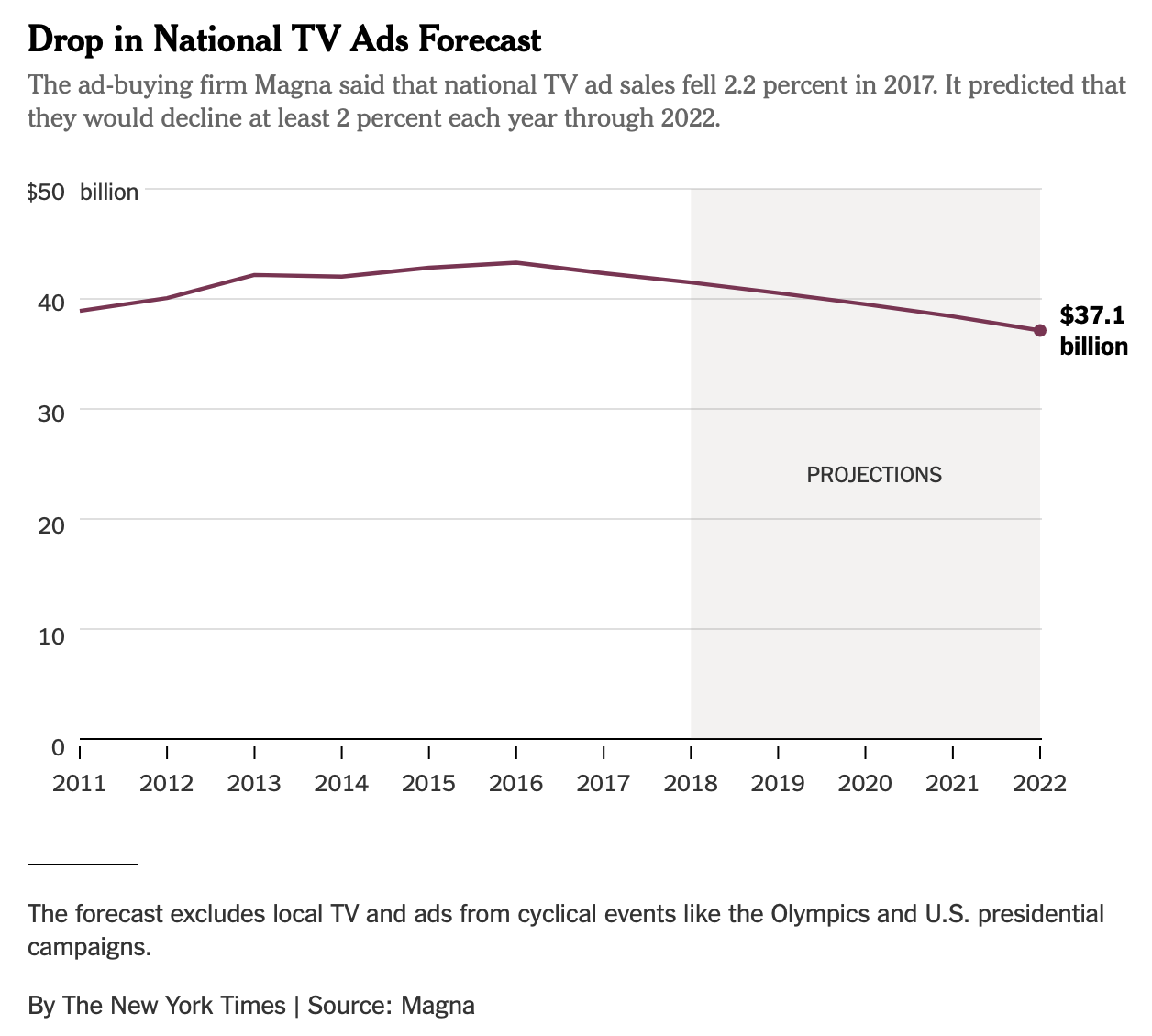
The average cost for just a 30-second spot on national TV is still over $650,000, but that’s less than it was a year ago.
While yesteryear’s mad men are over the hill, today’s content marketers are just starting to summit:
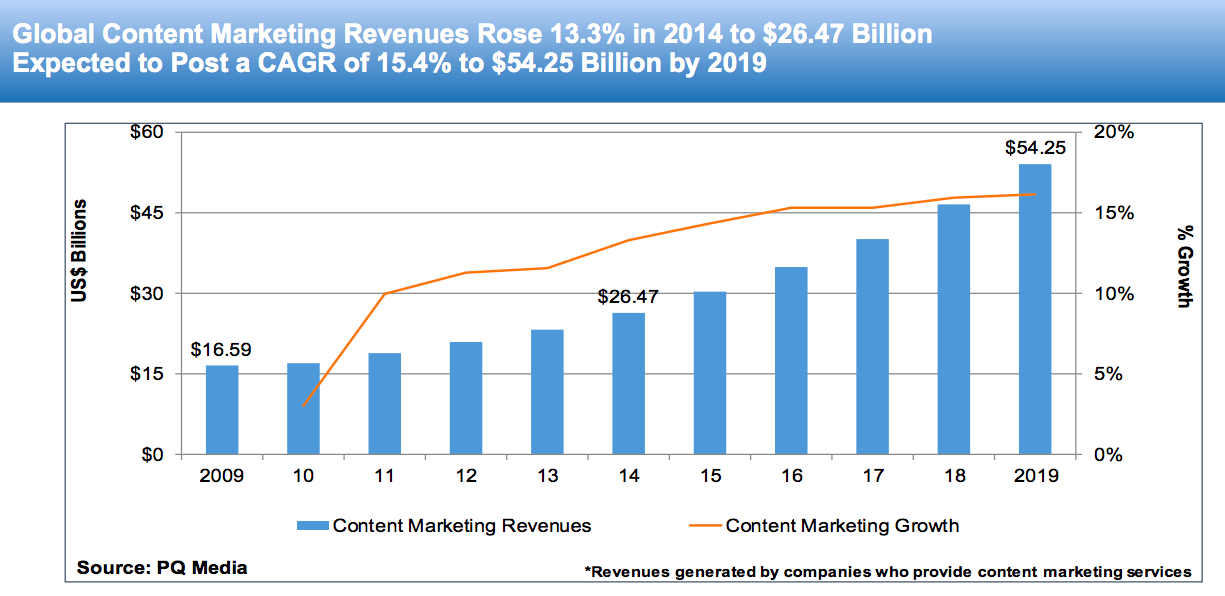
The average cost for just a 30-second spot on national TV is still over $650,000, but that’s less than it was a year ago.
While yesteryear’s mad men are over the hill, today’s content marketers are just starting to summit: (graph on LP)
Businesses are investing more heavily in marketing that doesn’t feel like marketing.
Other content marketing revenue projections are more bullish – to the tune of $300 billion in revenue by the end of this year.
This much is unanimous, though: Businesses are investing more heavily in marketing that doesn’t feel like marketing.
As Craig Davis, Co-founder and CMO of Sendle, put it: “We need to stop interrupting what people are interested in and be what people are interested in.”
That’s content marketing’s mission statement, if there ever was one.
Subscribe to
The Content Marketer
Get weekly insights, advice and opinions about all things digital marketing.
Thank you for subscribing to The Content Marketer!
The Competitive Advantage of Content Marketing
Again, when a commercial break comes on during half-time, timeout or between innings, there’s a chance you’ll go straight to your smartphone.
Let’s say you use that idle time to try to figure out how to care for the succulent you just bought.
You Google “succulent care.” The first result is from Gilmour.

You spend the next few minutes or so perusing this article and learn about the right soil, pot, sunlight conditions and fertilizer. When you’re about three quarters of the way through the article, this pops up on the screen:
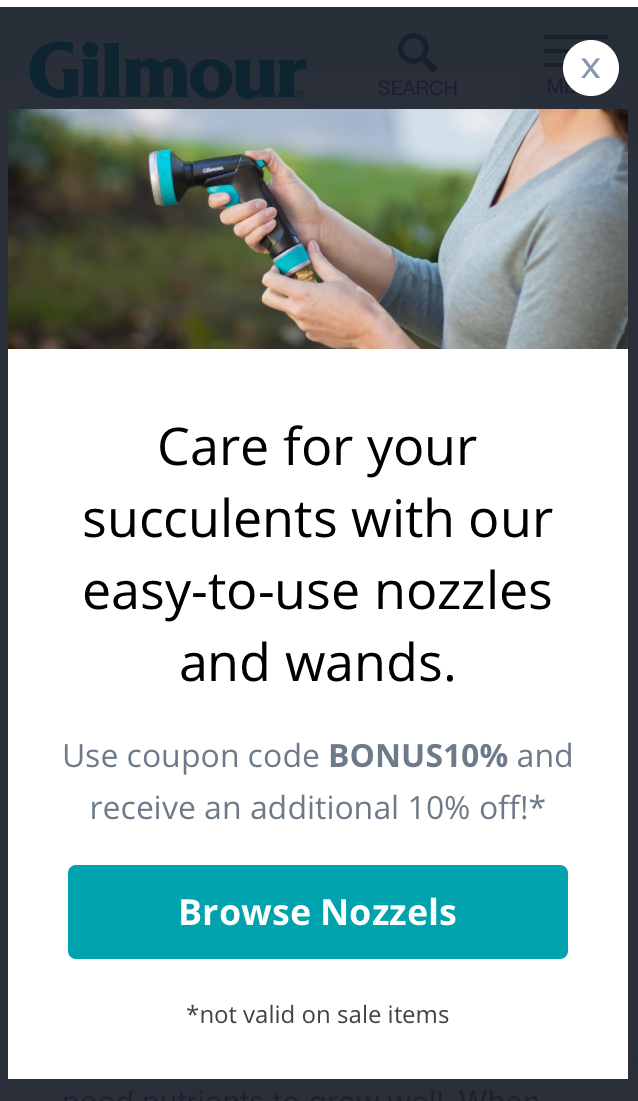
You spend the next few minutes or so perusing this article and learn about the right soil, pot, sunlight conditions and fertilizer. When you’re about three quarters of the way through the article, this pops up on the screen:
Up to that point, you had no idea what Gilmour was or that it sold anything at all. And maybe you don’t need a new hose nozzle right then so you just tap the “x.” Nevertheless, the brand has captured your attention by providing you something of value.
You now know Gilmour exists and you’re aware of what they sell, and Gilmour has achieved this goal at a fraction of what the muted TV commercial in the background costs.
That is the power of inbound marketing and understanding customer insights.
You understand your audience and your buyers and you know where in their journey to insinuate your brand so as to be helpful. Content research allows your business to zero in on the market you’d like to serve, take advantage of your audience’s position in the decision-making funnel, and gently show them the benefits of selecting your products or services.
Content and Your Inbound Marketing Strategy
Rebecca Lieb, author, strategic advisor and columnist said that, “content is the atomic particle of all digital marketing.”
It’s true.
Content is any format of messaging, branding or communication that you package for your audience across all marketing channels. Simply put, content is king.
But content does not achieve marketing objectives in a vacuum. It is not synonymous with content marketing.
Content creation is just one facet that needs to be considered in a strategic marketing planning process. You still need SWOT analysis (an assessment of your brand’s strengths, weaknesses, opportunities and threats in the market) and you still need to understand the customer journey in your market. This will help you create business goals.
Content marketing is about how you then use digital content to achieve those business goals and enhance customer experience.
In order to transpose a fully-formed content marketing message into effective digital content, the context of your message must also be taken into consideration. If content is king, context is most assuredly queen.
The context, or circumstance in which your audience absorbs your message, is what really matters. Factors such as the time of day, the quarter of an organization’s fiscal year, and your audience’s prior knowledge of your offerings can influence the degree to which your content resonates.
Although it is impossible to account for all of the variables, finessing both the content and context of your marketing strategy can turn casual observers into dedicated customers.
For example, Gilmour found an inroad with leads by ranking for the keyword, “succulent care,” and that’s not by chance. “Succulent care” has a high monthly search volume (18,000) and a low competition score, which makes it favorable:
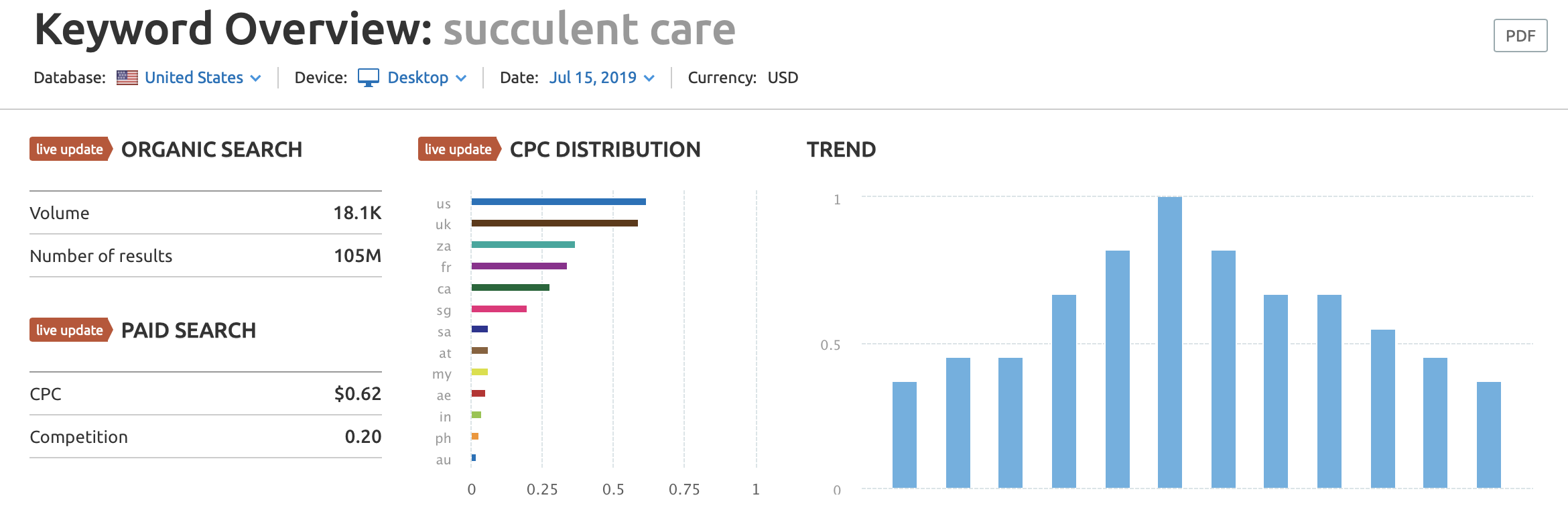
Equally important, it’s exactly the type of query that the typical buyer persona for a gardening equipment company might use in a Google search.
This means that, long before Gilmour created its content, it needed to know:
- Who its audience is.
- What information that audience cares about.
- How the audience might phrase a search for that information on the web.
- How to create content that those searchers will discover through those searches.
- How to engage that audience upon discovering that content.
This level of context provided Gilmour information relevant to their target audience. Outbound marketers who create TV commercials, billboards, ads on the subway, sales emails and other push marketing tactics might take some but not all of those factors into consideration.
But inbound marketers’ intent isn’t to talk at leads in an informed manner. It’s to provide information for those leads in order to create a consistent flow of inbound traffic for sales.
With content marketing, you’re not trying to figure out the most effective way to interrupt leads; you’re trying to make your brand useful so that they come to you. Cultivating experiences that are tailored to your audience, with content and messaging that speaks directly to their wants, requires market research and precision.
Clearly, then, content creation is just one part of content marketing.
Search engine optimization is another. I clicked on the Gilmour article because it was first in the results, and it was first because Google has determined based on a variety of search signals that that particular blog post did the best job at satisfying the intent of the search query “succulent care.”
Which brings us to an important question: What was Gilmour’s goal with this content? We can safely assume that all of the company’s long-term goals are centered around sales and loyalty (and maybe a buyout).
But this is an example of tactical marketing whereby content and SEO are used for brand awareness. This is a B2C market, after all. The sales cycle for a hose nozzle is shorter than it would be for a business IT solution that costs tens of thousands of dollars a year.
This means that the hardest part is to get the consumer’s attention, and content marketing has allowed Gilmour to do that without interrupting them.
Getting Deeper Into the Sales Funnel
Inbound marketing clearly has utility for B2C markets in a world that grows wearier of interruptive marketing by the year.
But there’s a reason content marketing is often more associated with B2B brands.
Firstly, for the majority of B2B businesses, the average sales cycle for new customers is about 4 months. With some exceptions, most B2C sales move faster.
A 30-second commercial or a display ad isn’t going to convince a CIO to go out and spend thousands of dollars a month on a new cloud-based e-commerce platform, but it might just convince you to buy a new type of sponge on your way home from work.
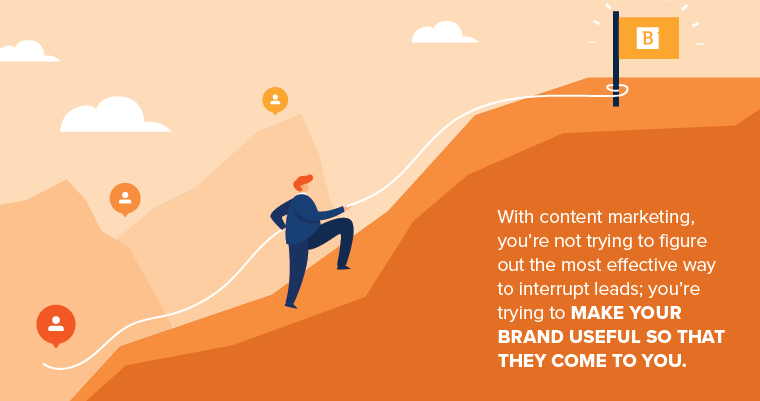
B2B brands need to spend a lot of time and effort convincing organizational influencers and decision-makers of their credibility and their worth. If branding needs to be vetted by a number of stakeholders or invested parties – each with their own opinions and biases – the sales cycle slows considerably. Content marketing can help them recognize a precise direction for the brand, and help expedite the approval process.
As with B2C brands, inbound marketing priority No.1 is brand awareness. Early digital marketing goals should cater to generating traffic to digital channels and capturing leads. That requires blog posts and how-to videos that address the types of questions your target audience might type into a search bar while they’re in work mode. Rank for those queries and address them better than your competitors.
Once you have leads’ attention, you need to hold it with the promise of more value in the form of newsletters and gated assets that provide insights and useful information. This is where mid-funnel assets like eBooks, white papers and infographics come into play.
In the next phase, you need to lean in with deep-funnel assets like case studies and testimonials and, finally, sales emails, offers for free competitor score cards, trials and other communications that help close deals.
The final phase is building brand loyalty and turning those loyal customers into advocates by creating case studies and testimonials that highlight those success stories. Having advocates for your brand is a grassroots marketing plan at its finest, as testimonials and good old fashioned word-of-mouth build trust and recognition amongst your target audience.
All the while, you’ll need to actively promote your content at the various phases of the sales funnel to help get more eyes on that content. That’s what email marketing campaigns and your social media strategy are for – that, and distributing content to leads and prospects when they’re ready to move down the funnel.
The moment your brand stops being useful is the moment it loses relevance.
You should also be tracking metrics this whole time. Tactical marketing demands that you set measurable goals at each stage of the sales funnel (more traffic, greater newsletter signups, more click-throughs on emails, more downloads of gated assets, demos scheduled, sales, rebuys etc.).
(And by the way, a lot of these efforts also apply to higher-value consumer assets such as automobiles, heating and cooling systems, loans, certain types of furniture and other home amenities).
It sounds like a lot to unpack, and it is. But at its core, the premise for this marketing process can be summed up as this:
Give your target audience something of value at every stage of the sales funnel. Because the moment your brand stops being useful is the moment it loses relevance.
The Last Type of Marketing
Which brings us full circle to the importance of a strategic marketing plan that is based on the status quo of marketing.
Marketing is less despotic than it’s ever been. Consumers have more options in terms of how they circumvent ads and sales pitches. By listening to feedback and altering best practices, today’s content marketers work to build rapport with their intended customer, rather than creating a divide.
The best marketers incentivize their target audiences to listen to what they have to say. They start conversations by being useful. And they nurture those conversations toward intent to purchase.
This is easier said than done.
It requires a marketing mix that might include, email, social media, blog posts, eBooks, white papers, case studies, landing-page copy optimized for the right keywords and formatted with UX in mind, and paid and organic strategies for how to make these assets work together.
It also requires talented content creators with the craft and skill to put real value on a webpage.
But all of these things are still far more attainable and cost-effective than a 30-second ad spot on national TV valued at $650,000, which, mind you, has ephemeral worth. Ad space has historically been stupidly exorbitant because it could be. For the first time in a long time, those prices are coming down, and that’s a huge deal.
The number of viable distribution channels has multiplied. TV and billboards aren’t top dogs anymore. Organizations now need really good content spread across many more digital touchpoints – web, search, social media, YouTube, e-commerce, etc. It’s as media theorists predicted in the ‘00s: The long tail is winning out over the short head.
Consequently, more organizations are diverting time, money and resources into content marketing. And as they do, the landscape gets more competitive.
Google’s algorithms, meanwhile, get smarter and more difficult to crack by the day. The strategic marketing process needs to be more calculated, data-driven, deliberate and well-executed than ever before, and the tactics need to be, at times, elaborate.
That increasing maturity and sophistication inevitably comes at a higher cost than the market demanded 5 years ago, but it still doesn’t monopolize a marketing budget the way traditional marketing has been allowed to for so long.
So where, exactly, does that leave us?
In a quest to increase the amount of thought, data, creative muscle and cross-department coordination that goes into organic, non-interruptive marketing.
That’s our frontier as marketers.
Editor’s note: Updated January 2025.
from Digital Marketing – Techyrack Hub https://ift.tt/qH2P8KZ
via IFTTT

No comments:
Post a Comment